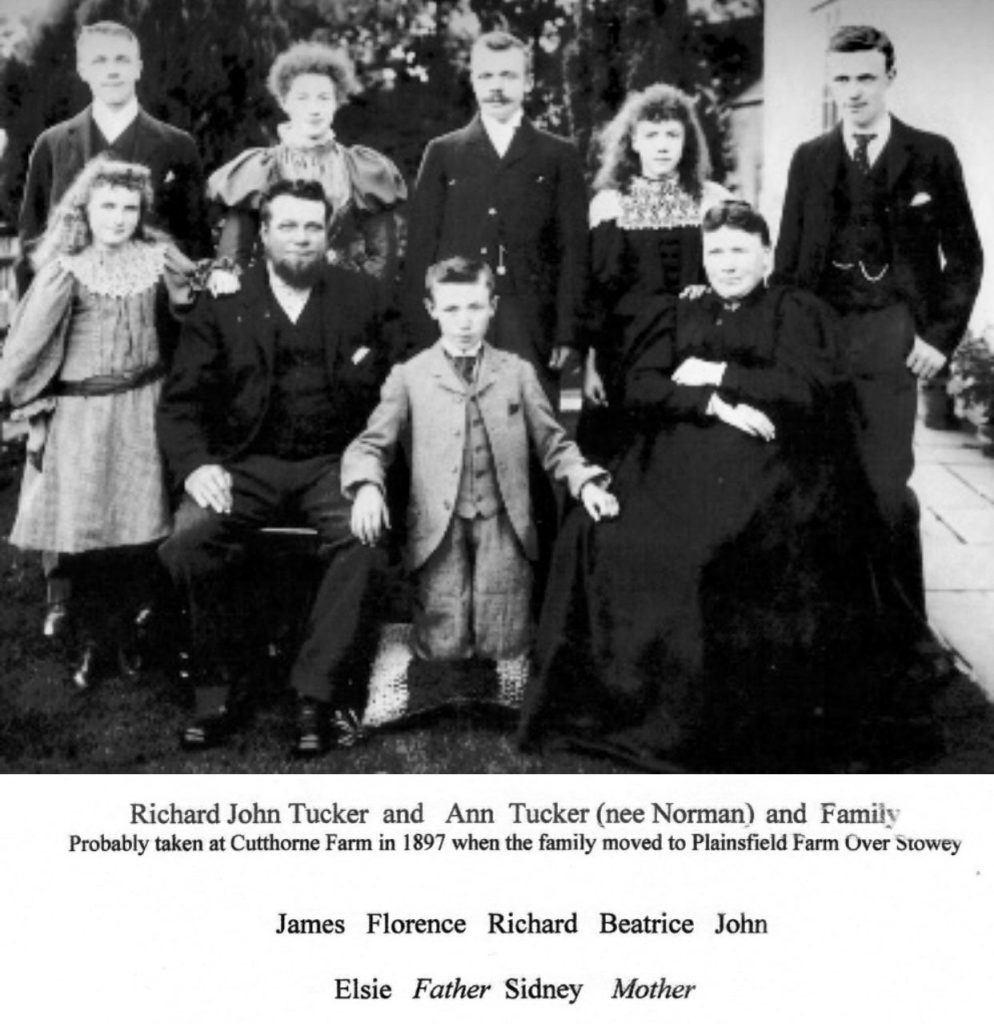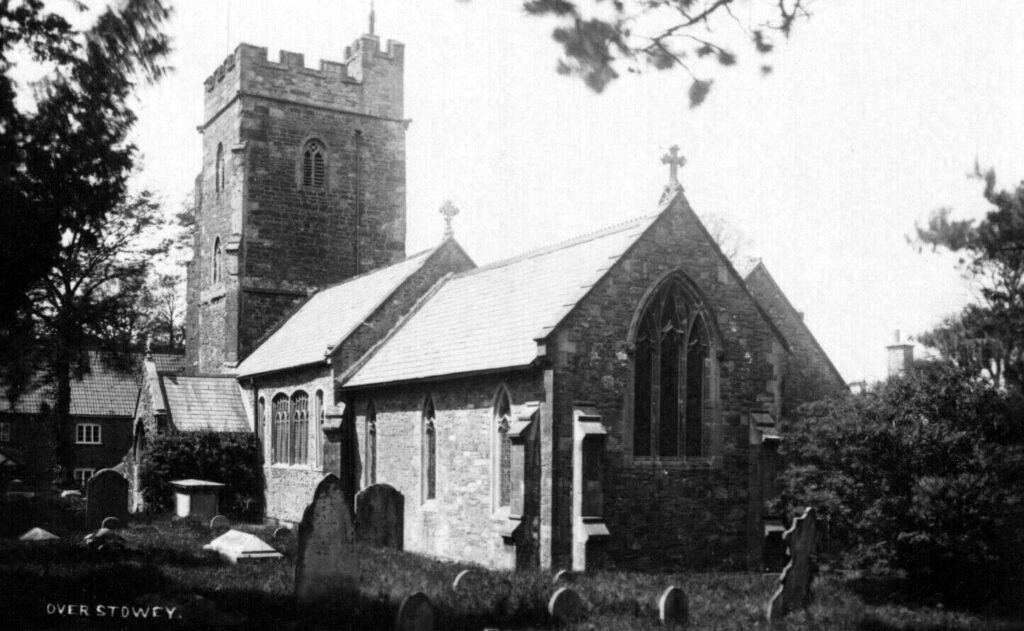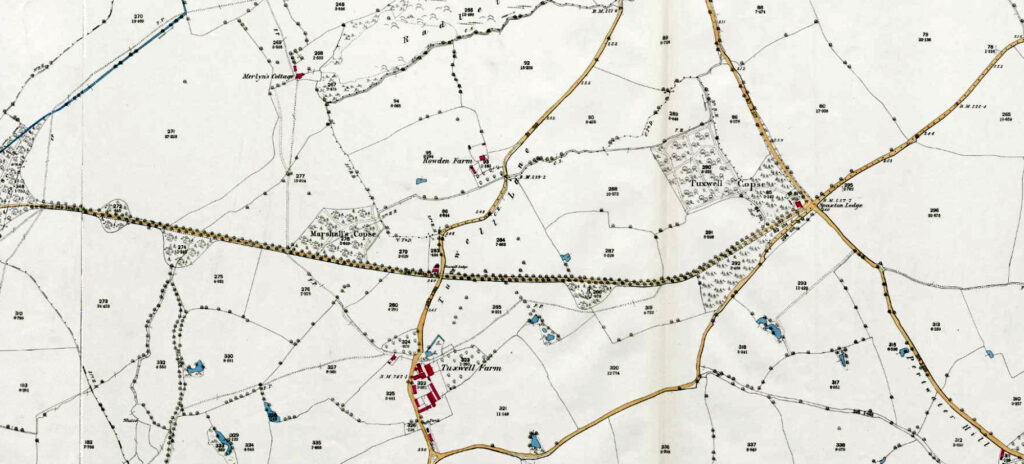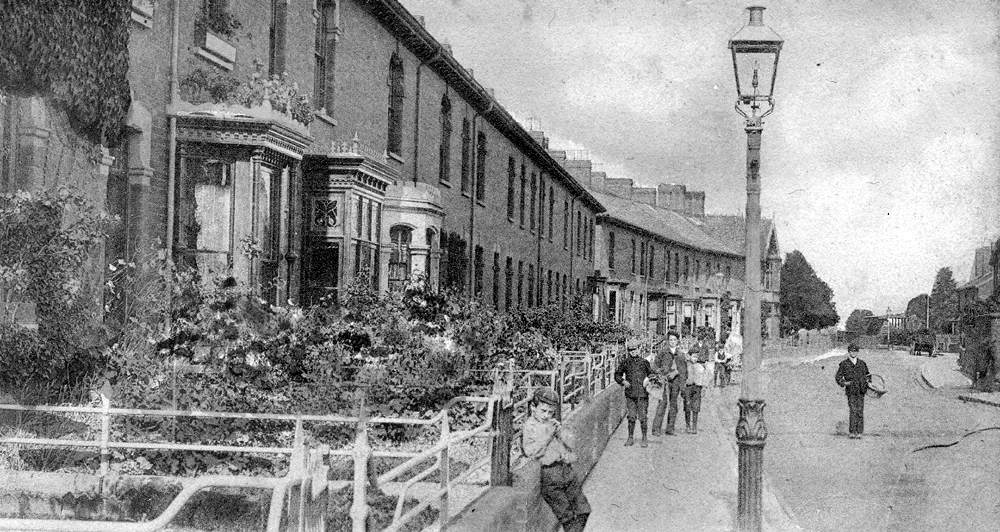James Tucker 1876 – 1915, Beatrice Ethel Tucker nee Sharam 1879 – 1915 and Joan Tucker 1915 – 1915
James (Jim) Tucker 1876 – 1915
Jim’s childhood
The Tucker family were Somerset farmers. Jim’s parents were Richard Tucker and Ann, nee Norman, and they were both born and lived in the village of Cutcombe, which is about 9 miles south of Minehead.
Richard and Ann married in Cutcombe in 1873, but they lived in the nearby village of Winsford for a few years, as their eldest son Richard (junior), and their second son James (Jim) were born there. By 1878, Richard had moved his young family to Cutthorne Farm in Cutcombe, where they lived for about 20 years, and had another five children[1]. This farm was about 295 acres, and Richard employed four men on the farm, and had several indoor servants, as well as his widowed father living with him.
Jim and his brothers were sent to boarding schools. At the age of 5, Jim was boarding at a school in Bridgetown, together with his elder brother Richard junior. The five year old Jim must have felt far away from his parents and farmhouse home. Ten years later Jim was boarding at Alcombe School in Dunster, together with his younger brother John.

Over Stowey
Around 1898, Richard and Ann, and their seven children, moved from Cutthorne Farm to Plainsfield Court Farm in Over Stowey.[2] This farm is close to the Quantock Hills, and Richard would have been keeping dairy cows. By 1901, a 24 year old Jim had left education and was living and working with his father on the farm. Richard’s daughters also helped their father by doing dairy work.
Living in Over Stowey and working with dairy cows would have lead Jim to meet his future wife Rose.
Rose Webber
Rose Webber was born in 1878 in the nearby village of Aisholt. Her parents, William Webber and Alice, nee Sayer, soon moved to Over Stowey, where William worked in a dairy as a dairyman. Rose was their eldest and only daughter, but William and Alice also had five sons [3]. In 1891, the 13 year old Rose was still at school, but sadly her mother Alice suffered poor mental health, and Rose had to take on more responsibility for the household when Alice was away.
In 1901 William Webber was working at Plainsfield Dairy, and Rose was living there as well. Whether they met in the dairy, or perhaps through the church, Jim Tucker and Rose Webber fell in love and were married on the 8th of October 1908 in the parish church St Peter and St Paul, and their two fathers were witnesses. Jim was 32 years old and Rose was 30. They had waited until they were able to set up home on their own farm at Rowdens, Spaxton, and Rose’s younger brothers were all adults.

The West Somerset Free Press of 10th October 1908 printed an account of their wedding.
“On Thursday last the wedding of Miss Rose Webber, only daughter of Mr and Mrs W Webber late of Plainsfield, and Mr James Tucker, son of Mr and Mrs R Tucker of Court Farm, Over Stowey, took place in the parish church. In the absence of the vicar (the Rev. H. Marshall), the Rev. F. Smith officiated. The hour fixed for the ceremony was 12.30, and previous to that the bridegroom arrived attended by Mr Sidney Tucker (brother) as best man, and, shortly after that, the bride entered the church attended by her father, who eventually gave her away.
She wore a dress of cream soline with a hat to match, and carried a handsome bouquet composed of roses, chrysanthemums and ferns. The bridesmaids were Miss Edith Browning (cousin of the bride) and Miss B. Tucker (sister of the bridegroom). They wore dresses of blue tussore silk with hats to match, and carried bouquets of choice flowers, all bouquets being gifts of the bridegroom. The bride having been a member of the choir for many years, the later attended and sang hymn 579, “O Father All creating”, and hymn 280 “Thine forever, God of Love”. As the bridal party left the church the organist played Mendelssohn’s “Wedding March”.
The wedding party drove to Rush Cottage, Spaxton, where Mr and Mrs W. Webber received several friends. Early in the afternoon Mr and Mrs James Tucker left for Torquay. They received a large number of very good and useful presents from friends far and near. Their future home will be ‘Rowdens’, Spaxton.”
This is clearly an account of a very happy family occasion, with the parents lovingly detailing the dresses and flowers, and the choir singing for their friend. The young couple set out to enjoy their honeymoon in Torquay and were looking forward to starting life in their new home. Twenty one days later there was another press article about the couple. This was a long article which will be transcribed in full at the end of this biography. The first section follows.
West Somerset Free Press 31st October 1908.
“Death of Mrs James Tucker. The truth ‘we know not what tomorrow brings forth’ has been tragically brought home to us by the death of Mrs James Tucker at Torquay. It was only on October 8th that she left our parish church amid the pealing of the organ and clashing of bells, a smiling and happy bride, and on Tuesday last she was born to the church she loved so much for the last rites to be observed. Reports reached us shortly after her marriage that a very serious ailment had developed and that an unsuccessful operation had been performed. She gradually sank after this, but for the remaining few days her unbounded faith and trust in God, her complete resignation to His Will, showed all those who ministered to her that her life of unselfishness was to have its due reward and that she was ready to forsake all here below and go to her Father’s home above; in this quiet and perfect peace she passed sweetly away at midnight on October 24th. A deep and widespread sympathy is felt for her sorrowing husband and parents.”
Rose’s death certificate revealed that the primary cause of death was ovarian cancer, and the emergency operation was a laparotomy. It is relatively unusual for someone as young as Rose to get this particular cancer. The symptoms of this disease may only present in the later stages of development, but Rose probably began to notice something was wrong before her wedding. However, the symptoms can be vague, such as a feeling of bloating or discomfort in the abdomen, which could be attributed to digestive disorders. Rose lived in a male household for much of the time, and may have had no close female relative nearby to ask for advice. She had waited a long time to get married, and must have been hoping that all would work out for the best.
Rose had been a bride for 16 days.
It is hard to imagine how devastated Jim felt by the loss of his young bride before they had even finished their honeymoon.
Shortly before his marriage, Jim had rented Rowden Farm in Spaxton. This farm had been advertised in the Somerset Free Press on the 11th of April 1908. It was described as having a homestead, cottage and orchard plot of 1 acre, over 105 acres of pasture and 52 acres of arable land. This was a farm mainly laid out for grazing animals, but with a third of the land available for crop growing.
Jim moved in, no doubt with a heavy heart, but he was kept company by his younger sister Elsie. Elsie helped with dairy work, and Jim and Elsie were living at Rowden Farm on the 1911 census. Jim kept around 150 sheep and over 40 cows on his farm, and several horses to help with farm work as well as for riding.

Rowden Farm was only six miles from Bridgwater, and Jim must have often ridden in to the town for the market, and to get supplies. While in Bridgwater, Jim met Beatrice Sharam.
Beatrice Ethel Tucker, nee Sharam 1879 - 1915
Beatrice Ethel Sharam was born in Torquay in Devon. She was the eldest child of Samuel Sharam and Eliza nee Luxton. Samuel was a tailor’s cutter, a skilled job involving the very accurate cutting out of expensive wool or linen fabric to an exact size, so that it could be sewn up by a seamstress or tailor. Both Samuel and Eliza were born in Devon, and they married in Newton Abbot in 1878.[4]
Soon after their marriage, Samuel and Eliza moved from Devon to Bridgwater. In 1881 they were living on Old Taunton Road with a 2 year old Beatrice and baby son Albert. Ten years later they were still living on Old Taunton Road, although they now had two more sons, Augustus and Walter.[5] Beatrice was at school.
By 1901, the family had moved to 49 Victoria Road, a comfortable red brick terraced house. Beatrice, (shown as Ethel) now aged 22 was not shown as working, although her younger brother Albert was working at home as a tailor and cutter. He was probably doing piece work, perhaps for the same tailor that his father worked for. Beatrice would have been helping her mother with domestic work, and may also have helped Albert with sewing. Samuel had retired by 1911, Beatrice was still at home with her parents, although her brothers were now going out to work, Albert as a tailor and Walter as a bank clerk. Augustus had already moved away from Bridgwater to work as a civil servant.

On the 16th of March 1912, 33 year old Beatrice Ethel Sharam married James Tucker at the Baptist Chapel in Bridgwater, and they lived at Rowden Farm, Spaxton. This must have been a very different way of life for Beatrice, who had grown up in the bustling town of Bridgwater. She would have had to adjust to life in the countryside as a farmer’s wife, and learn the skills needed for dairy work.
In 1914, Beatrice fell pregnant and both Beatrice and Jim must have been very happy about this. Their baby daughter Joan was born at Rowden Farm on the 8th of March 1915, but the baby was sickly and only lived for two hours. It is possible that the baby was premature.
On the following day, the 9th of March 1915, Beatrice herself died at home on the farm, aged 36. Her death certificate indicates that she had fallen ill at least nine days before the birth, with pulmonary congestion. This is a condition where there is too much fluid on the lungs, causing breathlessness and an irregular heartbeat. There are several possible causes of this, it is could be an indicator of pre-eclampsia, a condition of late pregnancy, which is potentially dangerous for both mother and unborn child. Or Beatrice may have had rheumatic fever in earlier life, resulting in heart damage. This illness was quite common before antibiotics were available. Or the pulmonary congestion might in fact have been pneumococcal pneumonia, the result of an infection. In her weakened state, Beatrice also caught tonsillitis five days before the birth, and the additional strain of labour proved too much for her.
Beatrice and baby Joan were buried together on the 12th of March 1915, in Wembdon Road Cemetery, in Nonconformist plan 6 13/663, just four days short of Beatrice’s third wedding anniversary.
Only two days after the funeral of his wife and baby, Jim himself fell ill with pneumonia and a very high temperature. Five days later Jim died at home at Rowden Farm on the 19th of March 1915, with his father beside him. The high temperature indicates that this was the result of a virulent infection, possibly caught at the funeral gathering, or even from Beatrice. Jim, in his grief, may not have had much will to get better, as the doctor attending him said to his family that Jim had died of a broken heart. Jim was buried with Beatrice and Joan on the 23rd of March 1915.
Jim, his second wife Beatrice and daughter Joan had all died within eleven days.
Jim’s sorrowing father Richard then had to deal with the practicalities of disposing of Jim’s livestock and farm equipment. Several advertisements were placed in local papers over the next year, offering the animals, agricultural equipment and domestic furniture for sale. [6]
Richard also had the sad duty of raising a memorial to his son, daughter in law and grand-daughter. The inscription on their headstone is -”Loving memory of James Tucker aged 38. And Beatrice Ethel his wife aged 36. Also their infant daughter Joan, who all entered into life March 1915.”

References
Ancestry.co.uk – Census records, probate records, birth, marriage and death records.
General Record Office – Copies of death certificates
Friends of Wembdon Road Cemetery website - https://wembdonroadcemetery.com/
National Newspaper Archive – Somerset Free Press
Taunton Courier and Western Advertiser
https://www.britishnewspaperarchive.co.uk/
Somerset HER and National Library of Scotland – historic map of Spaxton
Notes
The article about the funeral of Rose Tucker nee Webber, published in the Somerset Free Press on October 31 1908. [7]
Clare Spicer, Hilary Southall and Jill Trethewey 06/11/2022
[1] Children of Richard Webber and Ann nee Norman – Richard 1874, James 1876, John 1878, Florence 1881, Beatrice 1883, Sidney 1885 and Elsie 1887.
[2] Plainsfield Court Farmhouse is a Grade 2 listed building
https://historicengland.org.uk/listing/the-list/list-entry/1261338
[3] Children of William Webber and Alice nee Sayer – Rose 1878, Arthur 1879, Harry 1880, Reginald 1883, Edward 1884 and Cyril 1887.
[4] Sharam was an unusual name in the UK in the 19th century, mainly found in Devon. It was more common in Asia. Samuel’s grandfather John Baker Sharam was born in Devon in 1789.
[5] Children of Samuel and Eliza Sharam – Beatrice Ethel 1879, Albert 1881, Augustus 1886 and Walter 1889.
[6] Taunton Courier and Western Advertiser 30 August 1916 listed the sale of James Tucker’s stock. :-
“Rowdens Farm, Spaxton, About six miles from Bridgwater and nine from Taunton. Genuine sale of 150 Cross bred (Devon and Down) sheep, including:- 54 full-mouth breeding ewes; 15 two-teeth ditto; 15 fat-wether hogs; 65 ewe and wether lambs and one six-teeth Shropshire Down ram. 42 head of Devon and cross-bred cattle, including 4 young dairy cows, with calves at foot or in calf, in good season; 4 fat cows; 28 two and three year old grazing steers, in fine condition; 4 grazing maiden heifers and 2 heifer yearlings; 6 capital cart and hack horses and colts; a collection of agricultural implements, well made useful household furniture and dairy utensils, & &.”
[7] “Death of Mrs James Tucker. The truth ‘we know not what tomorrow brings forth’ has been tragically brought home to us by the death of Mrs James Tucker at Torquay. It was only on October 8th that she left our parish church amid the pealing of the organ and clashing of bells, a smiling and happy bride, and on Tuesday last she was born to the church she loved so much for the last rites to be observed. Reports reached us shortly after her marriage that a very serious ailment had developed and that an unsuccessful operation had been performed. She gradually sank after this, but for the remaining few days her unbounded faith and trust in God, her complete resignation to His Will, showed all those who ministered to her that her life of unselfishness was to have its due reward and that she was ready to forsake all here below and go to her Father’s home above; in this quiet and perfect peace she passed sweetly away at midnight on October 24th. A deep and widespread sympathy is felt for her sorrowing husband and parents. Her body arrived from Torquay on Tuesday evening, and was received into the church by the vicar, the Rev. H. J. Marshall, where it rested for the night. She was laid to rest in the cemetery on the following afternoon, the hour fixed for the service being 3pm, and by that time a large number of friends and acquaintances filled the church, and many floral tributes lay on and around the coffin. The vicar read the lesson and the Rev. G. Canning (rector of Street) took the remaining portion of the service at the grave. The choir were present and sang the hymn ‘Peace, perfect peace,’ at the conclusion of the lesson, and the hymn ‘On the Resurrection Morning’, at the graveside. Suitable voluntaries were played by the organist as the friends assembled, and the ‘Dead March’…as the funeral cortege left the building.
There followed a detailed list of the messages written on 22 floral tributes.
Rose was obviously much loved.
